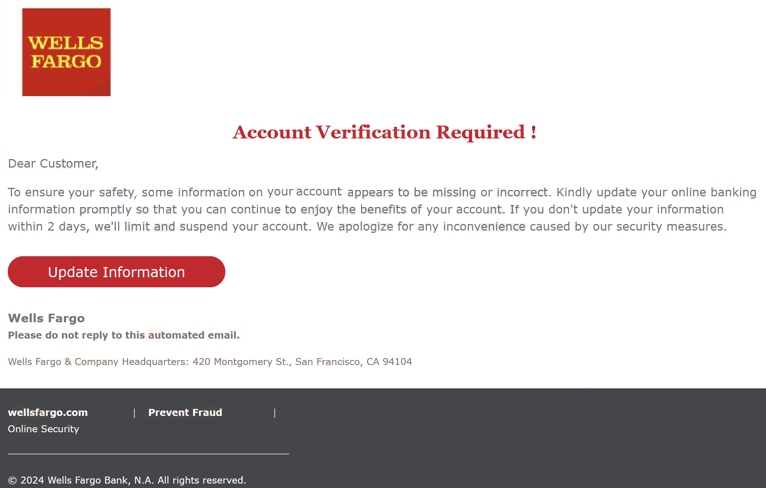“Wells Fargo – Account Verification Required” email falls into the phishing email category. The email is part of a larger campaign that targets Wells Fargo customers and tries to trick them into revealing their login credentials. The email claims that users’ accounts will be closed if they fail to provide some necessary information. It contains a link to a phishing site.
This “Wells Fargo – Account Verification Required” email claims that your account has certain information missing. If you do not provide this information, the sender claims that your account will be suspended. You are given 2 days to provide the necessary information. If you do not, the email claims your account will be limited or suspended.
To supposedly update your information, the email asks you to click the “Update Information” button. If you do that, you will be taken to a site that closely imitates the Wells Fargo login page. If you type in your username and password, you will likely get an error. However, your login credentials will be immediately sent to the cybercriminals operating this malicious phishing campaign. This could lead to your account being compromised and unauthorized transactions/purchases being made.
The full “Wells Fargo – Account Verification Required” email:
Subject: Online Banking Alert
Wells Fargo
Account Verification Required !
Dear Customer,
To ensure your safety, some information on your account appears to be missing or incorrect. Kindly update your online banking information promptly so that you can continue to enjoy the benefits of your account. If you don’t update your information within 2 days, we’ll limit and suspend your account. We apologize for any inconvenience caused by our security measures.
Update Information
Wells Fargo
Please do not reply to this automated email.Wells Fargo & Company Headquarters: 420 Montgomery St., San Francisco, CA 94104
wellsfargo.com | Prevent Fraud |
Online Security© 2024 Wells Fargo Bank, N.A. All rights reserved.
NMLSR ID 399801
Phishing emails are very common, and most users whose email addresses have been leaked in some way will receive one eventually. We strongly recommend that you become familiar with what phishing emails look like to avoid falling for them in the future.
How to recognize phishing emails
In many cases, it’s possible to recognize phishing emails as long as you know what to look for. Generic phishing emails are typically aimed at regular users and are relatively easy to recognize. However, more sophisticated phishing campaigns may target specific people whose information malicious actors have. As a general rule, phishing emails are designed to mimic legitimate correspondence from reputable companies. For instance, this “Wells Fargo – Account Verification Required” email tries to deceive recipients into believing it’s sent by Wells Fargo, a US-based financial service company. However, upon closer inspection, the email lacks the professional appearance associated with genuine emails from such institutions
One way to identify potential phishing emails is by checking how the email addresses the recipient. Legitimate emails often use personalized greetings, addressing recipients by their names. Phishing and other malicious emails, on the other hand, use generic terms such as “Customer,” “Member,” or “User”. This particular email addresses recipients as “Customers”, which banks do not do.
Another common characteristic of phishing emails is grammar and spelling mistakes. Legitimate emails from reputable companies typically undergo thorough proofreading and quality checks, and as such, are unlikely to contain such mistakes. In contrast, phishing emails often have obvious mistakes.
Phishing emails frequently use urgency or fear tactics to coerce recipients into clicking on embedded links and providing their login credentials. For example, an email claiming that there is an issue with the recipient’s bank account may prompt them to take immediate action. However, it is essential to refrain from clicking on any links in such emails. Instead, if you suspect an issue with an account of yours, manually access the relevant account to check what the potential issue is.
Finally, prior to typing any login credentials, always check the URL of the website. Phishing websites may closely resemble legitimate sites in appearance, but the URL will often reveal the scams. Malicious actors may utilize various techniques to make the URL appear authentic, but with careful attention to detail, the differences can be easily noticed. By remaining vigilant and thoroughly examining URLs, you can mitigate the risk of falling victim to phishing attempts.
Remove “Wells Fargo – Account Verification Required” email
If this email lands in your inbox, you can remove “Wells Fargo – Account Verification Required” email and ignore all of its contents. As long as you don’t interact with the email, it’s not harmful. However, if you now realize that you clicked on the link in the email and typed in your login credentials on a phishing site, you need to contact your bank immediately and inform them that your account was likely compromised. The longer you wait to contact your bank, the more likely is your account to be compromised.
Site Disclaimer
2-remove-virus.com is not sponsored, owned, affiliated, or linked to malware developers or distributors that are referenced in this article. The article does not promote or endorse any type of malware. We aim at providing useful information that will help computer users to detect and eliminate the unwanted malicious programs from their computers. This can be done manually by following the instructions presented in the article or automatically by implementing the suggested anti-malware tools.
The article is only meant to be used for educational purposes. If you follow the instructions given in the article, you agree to be contracted by the disclaimer. We do not guarantee that the artcile will present you with a solution that removes the malign threats completely. Malware changes constantly, which is why, in some cases, it may be difficult to clean the computer fully by using only the manual removal instructions.
